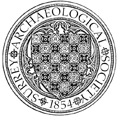Land at Knowle Lane, Cranleigh
Evaluation by O Rouard of TVAS revealed some dispersed undated linear features and a very sparse assemblage of Saxon and medieval pottery.

1066-1600
Evaluation by A Tynan of AOC recorded no archaeological features although a small piece of late medieval decorated floor tile, probably from Chertsey Abbey, was found in a made-ground deposit.
Evaluation by J Aaronson of CA within the Scheduled Monument of Chertsey Abbey revealed a considerable amount of residual medieval material, including pottery, tile and brick that undoubtedly derives from Chertsey Abbey, but is believed to be material previously sifted out during excavations carried out in 1954. Gravel layers were also revealed that may have formed part of an earlier path skirting the south and western sides of the mid-19th century Abbey Lodge.